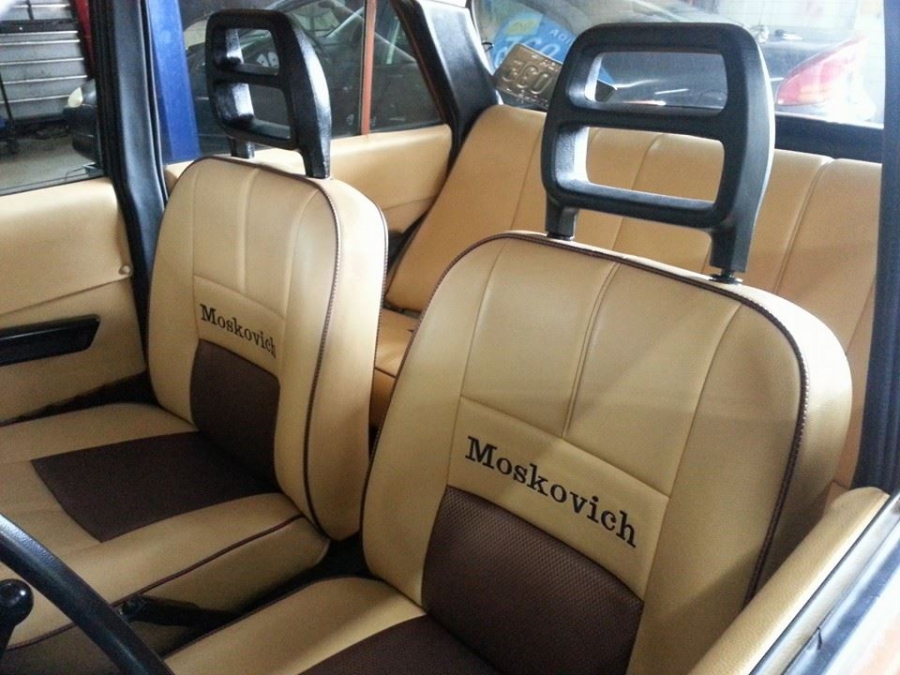

Contents • • • • • • • • • • Design [ ] The Moskvitch 412 derived from the, differing in more powerful 1.5 engine. The earliest engines for the M-412 were built in 1964. The Moskvitch-412 had a slanted (to a tilt of 20 degrees) with a block, head, and inlet manifold cast in to keep the engine weight down, and a.
Steel cylinder liners were replaceable to enable easy repair of the engine instead of having to replace it entirely. Since it was of an OHC design, it was taller than the OHV MZMA-408 engine it replaced, which is why it was mounted at a slant. The UZAM-412 had a capacity of 1,478 cc (90.2 cu in) c.c. And developed 75 horsepowers. Its more powerful version, the Moskvitch-412-2V, had 100 h.p. And was installed on sports cars. The 1,478 cc (90.2 cu in) UZAM-412 engine, with a light alloy block, was designed by Igor I.
Jul 31, 2018. 4, /media/system/js/mootools-more.js, mootools.
According to some observers, it bore some similarities to the contemporary BMW M 115 motor used in the model, although in other ways they are different from each other. The similarity between the two engines is purely superficial and limited only to the tilt angle of the and between the valves and the gear of the. The inherited from the M-408 was improved, with the gearbox ratios being revised to make better use of the increased power output. Until 1969, M412 had the gear lever on the steering column, just like M-408. From 1969 on, M-412 had the gear lever mounted on the floor.
M-408 had the gear level mounted on the floor since 1973. In 1969, both the M-412 and the related M-408 had their bodies redesigned. These were notable for being the first Moskvitch models to feature rectangular headlights and horizontal, which passed on to the in 1976, replacing round headlights (two on ordinary models, four mainly on export models) and vertical rear lights.
Only rear triangular turn signals remained on vestigial tailfins. Until then, the M-412 profited from heightened and tanned headlight lamps on export models. Another notable (but not unique, as it was used in other Russian cars at the time) feature were the so-called side signals, mounted on the C-pillars on some vehicles and similar to the American 'opera lights'. The designers 'had paid real attention to passive safety', the car was crash-tested, met the standards of safety adopted by the, and received an international safety certificate as a result of almost five months of tests in France. It was upgraded with dual-circuit braking system with power assistance (servo), disc brakes on the front wheels, reinforced car-body structure, and features such as soft grip steering wheel cover, soft interior parts, seat belts, and padded dashboard. It was the first Moskvitch to pass safety-features tests in,,, and in 1970–71, and in in 1972. The modernized model, both for export and domestic market, received a factory code M-412IE (IE for 'export rendition'), to mark, that it fulfils new safety requirements.
Izh/Moskvitch-412 rear view • IZh-412 practically similar to M-412, with slight changes in the frontal grille, most notably retaining twin round headlights. The car was still marketed as Moskvich 412 and had such name on a rear hood, while IZh-412 was a factory designation.
After a facelift in 1982 it received a black grille with indicators on outer sides of headlights, and hollow door handles (factory code IZh-412-028), and remained in production until 1997. • IZh-427 was a duplicate of the M-427, with no other changes beside the company logo. The car, however, entered in production only in 1971 because of the abundance in Moskvitch variants. • – surnamed 'Kombi', was the first Soviet hatchback series produced from 1973 to 1982, then after a facelift as IZh-21251. It was then kept in production until 1997.
• IZh-2715 was IZh's panel van variant with a high roof, produced from 1972 until 2001. In 1982 it underwent a facelift, along with other IZh models (IZh-2715-01 code). • IZh-27151 was IZh's pick-up truck, produced from 1974 until 2001. After a facelift in 1982 it was designated IZh-27151-01, or IZh-27151-013-01 in lengthened version. Relationship to the M-408 [ ].
M-412 dashboard The original M-412 of 1967–69 had a identical to that of the, which had been launched three years earlier in 1964. The only differences between the two models were the engines and the interior. The main differences between the Moskvitch-412 and the Moskvitch-408 were: Moskvitch 412 Moskvitch 408 Production 19–76 Engine model 412 408 Chassis 408 (1967–69); 412 (1969–76) 408 (1964–69); 412 (1969–70) Successor Moskvitch 2140 Moskvitch 2138 The differences between the 412/408 chassis: 19–69 Features Square headlights; horizontal rear lights; triangular rear turn signal markers; separated front seats; floor-mounted gearshift lever (except for the 408, which had column-mounted shifter until 1973). 2 or 4 (twin) round headlights (Izh-412: 1967 –1982); vertical rear lights; front bench seat (until 1968); column-mounted gearshift lever (on the 408 until 1973, on the 412 until the fall of 1968). Prototype variants [ ] In 1970, Moskvitch built a prototype of the, a restyled hatchback version of the M-412 that was larger but recognizably related. The of 1972 was larger still, with 23 cm (9.1 in) greater length, 14 cm (5.5 in) more, and 8 cm (3.1 in) more width.
- Author: admin
- Category: Category
Search
Recent Posts

Contents • • • • • • • • • • Design [ ] The Moskvitch 412 derived from the, differing in more powerful 1.5 engine. The earliest engines for the M-412 were built in 1964. The Moskvitch-412 had a slanted (to a tilt of 20 degrees) with a block, head, and inlet manifold cast in to keep the engine weight down, and a.
Steel cylinder liners were replaceable to enable easy repair of the engine instead of having to replace it entirely. Since it was of an OHC design, it was taller than the OHV MZMA-408 engine it replaced, which is why it was mounted at a slant. The UZAM-412 had a capacity of 1,478 cc (90.2 cu in) c.c. And developed 75 horsepowers. Its more powerful version, the Moskvitch-412-2V, had 100 h.p. And was installed on sports cars. The 1,478 cc (90.2 cu in) UZAM-412 engine, with a light alloy block, was designed by Igor I.
Jul 31, 2018. 4, /media/system/js/mootools-more.js, mootools.
According to some observers, it bore some similarities to the contemporary BMW M 115 motor used in the model, although in other ways they are different from each other. The similarity between the two engines is purely superficial and limited only to the tilt angle of the and between the valves and the gear of the. The inherited from the M-408 was improved, with the gearbox ratios being revised to make better use of the increased power output. Until 1969, M412 had the gear lever on the steering column, just like M-408. From 1969 on, M-412 had the gear lever mounted on the floor.
M-408 had the gear level mounted on the floor since 1973. In 1969, both the M-412 and the related M-408 had their bodies redesigned. These were notable for being the first Moskvitch models to feature rectangular headlights and horizontal, which passed on to the in 1976, replacing round headlights (two on ordinary models, four mainly on export models) and vertical rear lights.
Only rear triangular turn signals remained on vestigial tailfins. Until then, the M-412 profited from heightened and tanned headlight lamps on export models. Another notable (but not unique, as it was used in other Russian cars at the time) feature were the so-called side signals, mounted on the C-pillars on some vehicles and similar to the American 'opera lights'. The designers 'had paid real attention to passive safety', the car was crash-tested, met the standards of safety adopted by the, and received an international safety certificate as a result of almost five months of tests in France. It was upgraded with dual-circuit braking system with power assistance (servo), disc brakes on the front wheels, reinforced car-body structure, and features such as soft grip steering wheel cover, soft interior parts, seat belts, and padded dashboard. It was the first Moskvitch to pass safety-features tests in,,, and in 1970–71, and in in 1972. The modernized model, both for export and domestic market, received a factory code M-412IE (IE for 'export rendition'), to mark, that it fulfils new safety requirements.
Izh/Moskvitch-412 rear view • IZh-412 practically similar to M-412, with slight changes in the frontal grille, most notably retaining twin round headlights. The car was still marketed as Moskvich 412 and had such name on a rear hood, while IZh-412 was a factory designation.
After a facelift in 1982 it received a black grille with indicators on outer sides of headlights, and hollow door handles (factory code IZh-412-028), and remained in production until 1997. • IZh-427 was a duplicate of the M-427, with no other changes beside the company logo. The car, however, entered in production only in 1971 because of the abundance in Moskvitch variants. • – surnamed 'Kombi', was the first Soviet hatchback series produced from 1973 to 1982, then after a facelift as IZh-21251. It was then kept in production until 1997.
• IZh-2715 was IZh's panel van variant with a high roof, produced from 1972 until 2001. In 1982 it underwent a facelift, along with other IZh models (IZh-2715-01 code). • IZh-27151 was IZh's pick-up truck, produced from 1974 until 2001. After a facelift in 1982 it was designated IZh-27151-01, or IZh-27151-013-01 in lengthened version. Relationship to the M-408 [ ].
M-412 dashboard The original M-412 of 1967–69 had a identical to that of the, which had been launched three years earlier in 1964. The only differences between the two models were the engines and the interior. The main differences between the Moskvitch-412 and the Moskvitch-408 were: Moskvitch 412 Moskvitch 408 Production 19–76 Engine model 412 408 Chassis 408 (1967–69); 412 (1969–76) 408 (1964–69); 412 (1969–70) Successor Moskvitch 2140 Moskvitch 2138 The differences between the 412/408 chassis: 19–69 Features Square headlights; horizontal rear lights; triangular rear turn signal markers; separated front seats; floor-mounted gearshift lever (except for the 408, which had column-mounted shifter until 1973). 2 or 4 (twin) round headlights (Izh-412: 1967 –1982); vertical rear lights; front bench seat (until 1968); column-mounted gearshift lever (on the 408 until 1973, on the 412 until the fall of 1968). Prototype variants [ ] In 1970, Moskvitch built a prototype of the, a restyled hatchback version of the M-412 that was larger but recognizably related. The of 1972 was larger still, with 23 cm (9.1 in) greater length, 14 cm (5.5 in) more, and 8 cm (3.1 in) more width.
Search
Recent Posts
